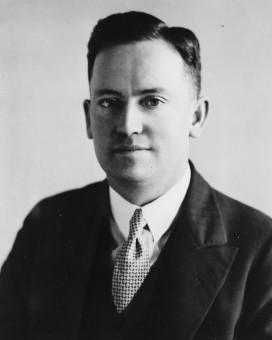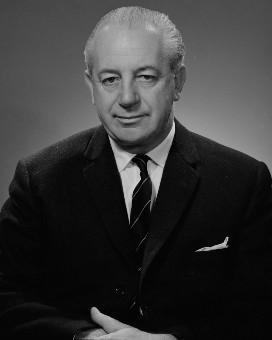On this page
1920 to 1929
17 Nov 1928: 1st elected to Federal Parliament
Chifley was elected as Member of Parliament for the seat of Macquarie (NSW), in the 11th federal election.
1930 to 1939
19 Dec 1931: Lost seat
Chifley lost his seat of Macquarie in the 13th federal election, along with 32 other Labor MPs in a landslide defeat.
1940 to 1949
21 Sep 1940: Regained seat
Chifley was re-elected a Member of Parliament for the seat of Macquarie (NSW), in the 16th federal election.
7 Oct 1941: Treasurer
Chifley is appointed Treasurer by new appointed Prime Minister John Curtin. He also became Minister for Post-War Reconstruction on 22 December 1942.
13 Jul 1945: 16th Prime Minister
After Curtin’s death on 5 July, Chifley was elected leader of the Labor Party on 12 July and sworn in as prime minister the following day.
6 Aug 1945: Hiroshima
The first atomic bomb was dropped on the Japanese city of Hiroshima. A second bomb was dropped on Nagasaki 3 days later. On 15 August, Japan surrendered, ending the war in the Pacific.
17 Oct 1945: Peace time intelligence
The Commonwealth Investigation Service was formed. It combined the wartime Security Service and the Investigation Branch.
10 Jul 1946: Parliament at home
Proceedings in the House of Representatives were broadcast for the first time. Legislation required the ABC to relay the parliamentary sessions on the interstate radio network. Senate broadcasts began a week later.
15 Aug 1946: Coal Board
Under an agreement with the New South Wales government, a Joint Coal Board was established. It enabled the government to continue the regulation of coal production, distribution and prices managed during the war by the Commonwealth Coal Commissioner. Coal production tripled in the next 25 years. In 2002, the Board was replaced by a private company, Coal Services Pty Ltd.
28 Sep 1946: National social security
A referendum to alter Section 51 of the Constitution was successful. It granted the Commonwealth power to provide maternity allowances, widows pensions, child endowment, unemployment, pharmaceutical, sickness and hospital benefits, medical and dental services, and student and family allowances. 2 proposals related to marketing and industrial employment were not carried. The referendum was held with the 18th federal election.
28 Sep 1946: 18th federal election
Labor defeated the new Liberal-Country Party Coalition, retaining government with a reduced majority.
13 Dec 1946: Papua New Guinea
The United Nations granted Australia trusteeship of New Guinea and Papua. The 2 regions were administered jointly, with the capital at Port Moresby.
11 Mar 1947: 12th Governor-General
Sir William McKell served as Governor-General until 8 May 1953. Lord Northcote was acting Governor-General from 19 July to 14 December 1951.
1 Apr 1947: Woomera
The Woomera rocket range was established as a joint facility for testing British and Australian short and long-range missiles. The range was sited within the 127,000km2 Woomera Prohibited Area in the northwest of South Australia. From 1957, the facility has also been used for Australia’s space program.
01 Jul 1947: Good news
At 7pm, the first ABC news broadcast under amendments to the Broadcasting Act was aired. The changes aimed at removing bias by requiring all news to be produced by ABC journalists, rather than gathered from commercial sources.
21 Jul 1947: Displaced persons accepted
Australia’s Minister for Immigration Arthur Calwell signed an agreement with the United Nations Refugee organisation to accept displaced persons from European countries ravaged by war.
18 Nov 1947: General Agreement on Tariffs and Trade
Australia applied the reduced tariffs under the GATT, signed in Geneva that year. The agreement established an international forum to encourage free trade between members by reducing tariffs on traded goods and by providing a means for resolving trade disputes.
26 Dec 1947: Antarctic territories
Britain transferred Heard and MacDonald Islands in Antarctica to Australia. The Australian National Antarctic Research Expedition (ANARE) was established in August. Scientific stations were set up on Heard Island in December, and on Macquarie Island the following May, using the small vessel Wyatt Earp.
1 Jan 1948: 40-hour week
Workers covered by Commonwealth awards began the reduced 40-hour week. The date for the change had been set by the Conciliation and Arbitration Court in September 1947.
29 May 1948: Referendum
A proposal to give the Commonwealth Parliament ongoing power to make laws with respect to rents and prices was not carried.
24 Jun 1948: National sea and air lines
The Qantas Empire Airways Act meant Australia’s only overseas airline was now publicly owned. In 1948, the government also re-established a Commonwealth shipping line.
21 Sep 1948: United Nations president
Australia’s Minister for External Affairs, HV Evatt, was elected president of the United Nations General Assembly.
29 Nov 1948: First Holden
Chifley launched the first Holden ‘family motor car’ off the assembly line. 10 years later, 500,000 Holdens had been produced.
26 Jan 1949: Australia’s first citizens
The Nationality and Citizenship Act came into operation, creating Australian citizenship. Although Australians remained British subjects, they were now citizens of their own country. The Act retained the definition of ‘aliens’ as those not British subjects. Irish citizens and ‘protected persons’ within the British Commonwealth were excepted.
16 Mar 1949: ASIO established
The Australian Security Intelligence Organisation was established to protect the Commonwealth from espionage, sabotage and subversion.
11 May 1949: More seats in Federal Parliament
The 1948 Representation Act was enacted. It increased the House of Representatives from 75 to 122 seats, including a new member for the Australian Capital Territory, and the Senate from 36 to 60 seats. The Commonwealth Electoral Act introduced proportional representation for Senate elections.
12 Sep 1949: Planting the national garden
Chifley planted a eucalypt at the entrance of the National Botanic Gardens during a visit by international foresters. The gardens had been established at Black Mountain in Canberra 4 years earlier.
17 Oct 1949: Snowy scheme
Work began on the Snowy Mountains Hydro-electric scheme to divert water from the upper Snowy River through tunnels and dams. The scheme aimed to generate electricity for New South Wales, Victoria and the Australian Capital Territory, and provide water for irrigation along the Murray and Murrumbidgee rivers. This major postwar development project employed many immigrant workers and was completed in 1974.
10 Dec 1949: 19th federal election
Chifley’s Labor government was defeated by the Liberal-Country Party Coalition under Robert Menzies.
19 Dec 1949: Left office
Chifley’s term as prime minister ended on 19 December 1949, when Menzies was sworn in after the federal election 9 days before. He remained in Parliament as Leader of the Opposition and Member for Macquarie until his death.
1950 to 1959
13 Jun 1951: Death
Chifley suffered a heart attack in his room at the Hotel Kurrajong in Canberra. Hey died in an ambulance on the way to the Canberra Community Hospital.





